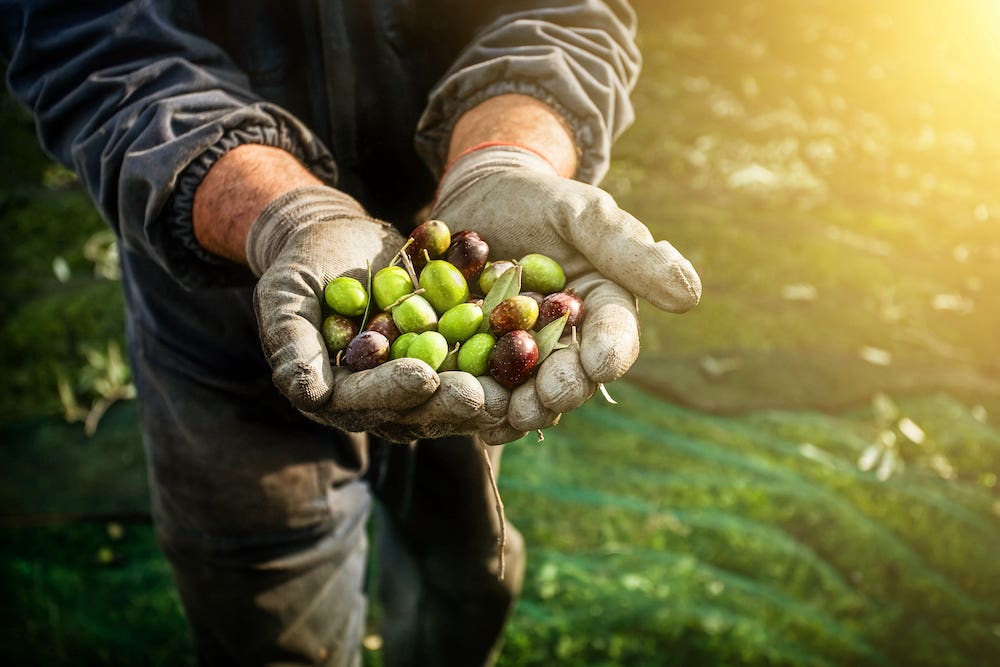
All About Olives: Everything You Need to Know to Select, Store, and Use Them
Any olive lover will tell you: There’s nothing quite like the meaty, tangy, salty, rich taste of table olives. Olives are unique in so many other ways, as well, from how they measure up nutrition-wise, to how they’re cured to make them tasty enough for consumption. Here’s everything you need to know to enjoy olives, including cooking, pitting, selecting and storing.
What Are Olives, Anyhow?
With their hard pits surrounded by flesh, olives are actually stone fruits (drupes) like cherries and peaches. But the fruit similarity ends there. Olives have a low sugar content (only 3% to 6%) and high fat content (12% to 30%), while other stone fruits have almost no fat and up to 30% natural sugar content. Olives also contain oleuropein, a bitter compound that makes them inedible when fresh. Green or black, colossal or tiny, all olives must undergo a curing process to remove that bitterness and preserve them. Due to olives’ high fat content plus the salt needed to cure them, Forks Over Knives recommends consuming them in moderation.
Black, Green, Purple Olives: What’s the Difference?
As olives ripen, they turn from bright green to purple to black. Green olives are olives that have been harvested when they are fully mature but haven’t changed color. Black olives are completely ripe when harvested. Purple olives, including Greek kalamatas, are picked somewhere in between the unripe and fully ripe stages. When the olives are picked determines the texture and flavor they will have after curing. Most olives are interchangeable in recipes, but flavors will vary depending on the type you use. Here are the most common types of table olives (as opposed to olives pressed for oil).
Types of Olives
Do you prefer your olives mild and meaty? Buttery and soft? Bold and chewy? Tangy? Spicy? Big and tender, or small and intense? How olives taste depends on the type, where they were grown, and how they were flavored. But the biggest flavor factor comes from how olives are cured. Here’s a quick rundown of the three most common olive-curing methods along with their general flavor profiles.
Spanish or Lye Cured: Mild and Meaty
Castelvetrano, Manzanilla, Gordal (aka Queen), California Ripe, and Mission
Don’t be scared by the term “lye-cured”: Food-grade lye is a GRAS (Generally Recognized as Safe) additive that is used to quickly and efficiently extract olives’ bitter compounds. Lye curing yields firm olives that range from mild to sweet in flavor and are large enough to be stuffed and sliced. The process is sometimes called Spanish or Seville-style curing because it originated in Spain. Lye curing is used extensively outside Spain, including California, where the addition of an iron compound to black ripe olives makes and keeps turns ripe black olives absolutely jet black.
Brined: Buttery and Tender
Kalamata, Sicilian, Picholine, Niçoise, Gaeta, Manzanilla
Brined olives are soaked in a salt solution to draw out their bitter compounds and infuse them with flavor. They can be black, purple, or green and are plump, buttery, and juicy. Brined olives are also the ultimate olive for stuffing because of their size and firmness.
Dry-Cured or Oil-Cured: Robustly Salty and Chewy
Greek-style olives, Moroccan Beldi olives, French Nyons olives
Fresh black olives are first crushed or cracked, then packed in salt for a month or more to draw out moisture and bitterness. They’re then soaked and rinsed to remove excess salt, dried, and coated in olive oil—which is why they are often labeled as oil-cured olives. Dry-cured olives have a robust flavor and hearty texture that is enhanced when they’re tossed with herbs, spices, and citrus.
Olive Selection
Whether you’re grabbing a jar or helping yourself to items at the olive bar, look for olives that appear firm, not mushy, and are uniform in size. Opt for pitted olives if you want pretty slices.
How Long Are Olives Good For?
Olives from the olive bar should be refrigerated and consumed within a week of purchase. Jarred and canned olives will keep up to one year in the fridge as long as they remain submerged in brine. If your jar doesn’t have enough brine to cover the olives, top it up with a salt solution made by dissolving 1 tsp. salt into ½ cup hot water. (Allow it to cool before using.)
How to Use Olives in Your Favorite Dishes
Olives are easy to add to all kinds of foods: The trick is knowing how many to use so you don’t overdo it on salt, fat, or that intense olive taste. When you want to include them in a recipe, a good rule of thumb is to count 1 to 2 tablespoons of olives per serving.
The Best Way to Pit Olives
Place olives one by one on a cutting board. Set the flat side of a large chef’s knife on top of the olive. Tap on the knife with your fist to flatten the olive and loosen the pit from the flesh. Use your fingers to remove the pit from the cracked olive.
Olive Recipes to Try
Pizza, pasta, salads, spreads, and so much more—here are some of our favorite olive-laced dishes.
- Vegan Niçoise Salad Bowls
- Roasted Tomato, White Bean, and Olive Bruschetta
- Penne with Swiss Chard, Olives, and Currants
- Stuffed Poblano Chile Peppers
- Mediterranean Pepper and Squash Hash with Creamy Polenta
- Bean & Corn Enchiladas
- Sun-Dried Tomato and Caramelized-Onion Focaccia
- Greek Salad with Sun-Dried Tomato Tofu Feta
- Simple Vegan Pita Pizzas
About the Author

About the Author
Mary Margaret Chappell
Join our mailing list
Get free recipes and the latest info on living a happy, healthy plant-based lifestyle.
By providing your email address, you consent to receive newsletter emails from Forks Over Knives. We value your privacy and will keep your email address safe. You may unsubscribe from our emails at any time.
